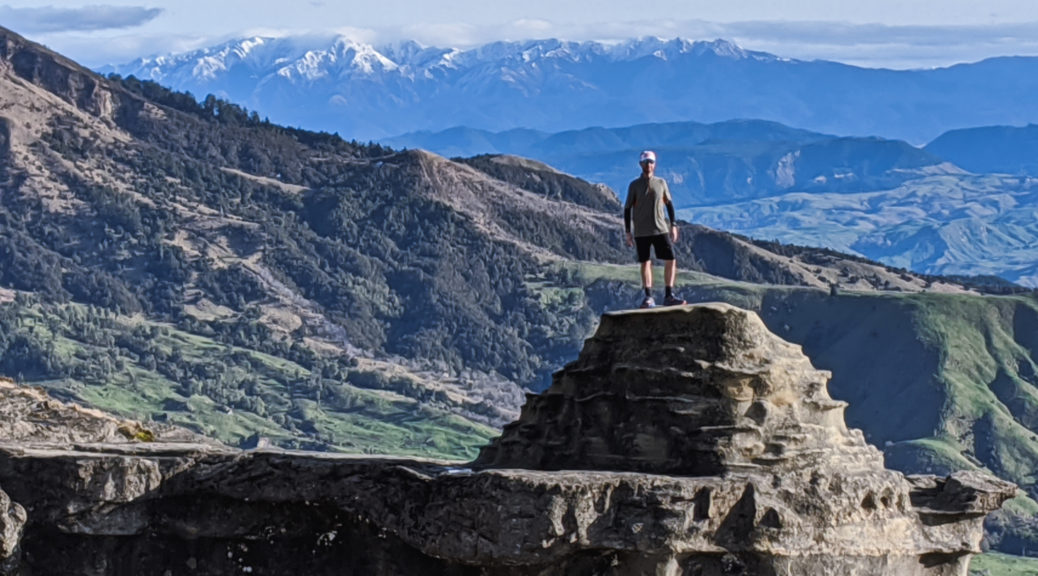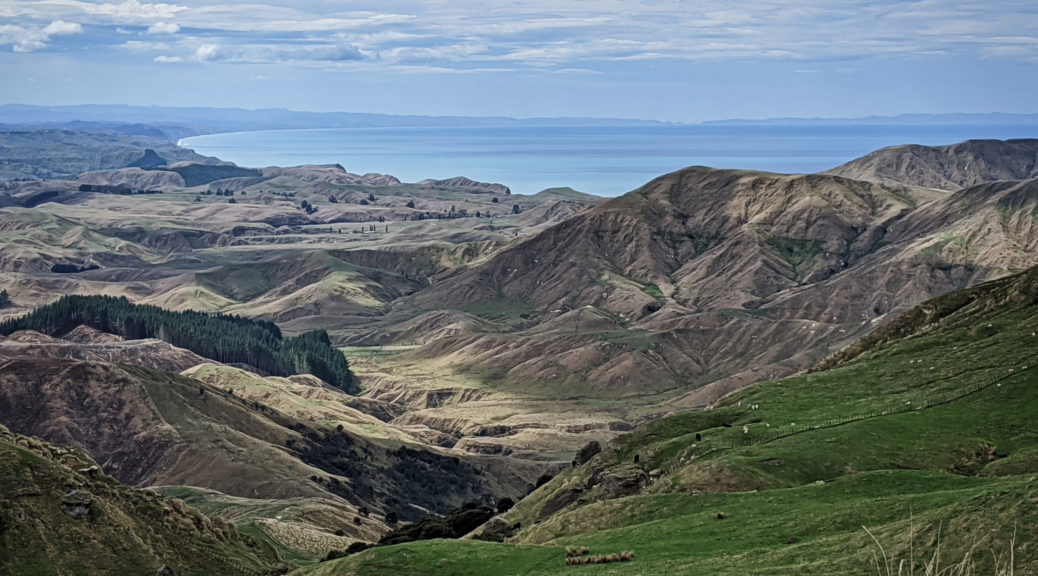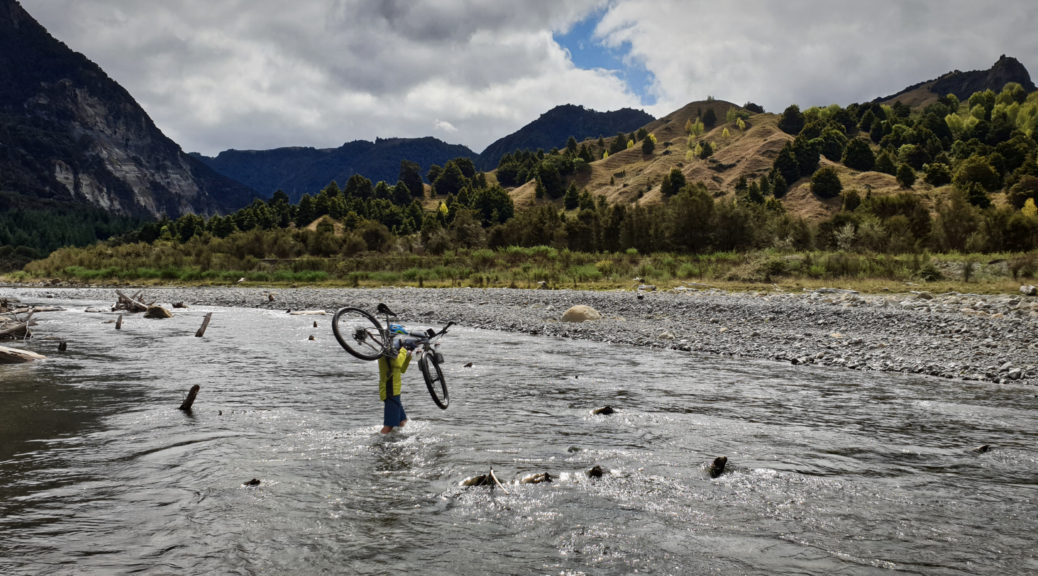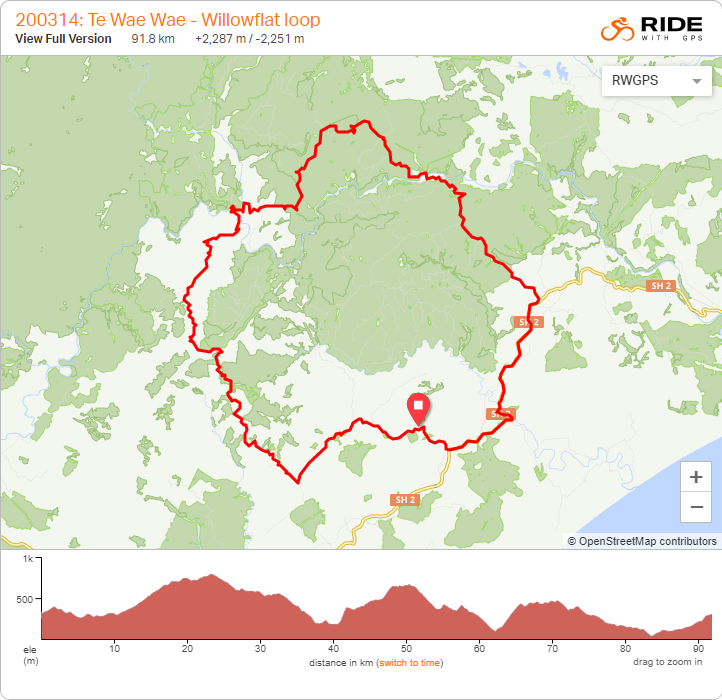With a recent foray into small trail runs, I started looking for a suitable day to finally get up to Bell Rock. It’s notoriously windy up there, the kind of wind where people my size struggle to stand up. Liking to stay near the ground when running, I patiently waited for a clear day (the views are one of the drawcards) with little wind.
After a week of wintry weather, and while the first park run in months tired me out, I was not wasting a glorious Saturday afternoon. Quite a drive later, I was at the trailhead rather counting on that I’d get back before dark. Only three kilometres out, the trail starts with a steep, rooty and slippery section through native bush. I was slow enough not to injure myself, before emerging onto the ridge – the sheltered side it turned out.
 Those hills on the coast became more familiar the following day.
Those hills on the coast became more familiar the following day.
Longer, tussocky grass surrounded and then turned into the route. In the shaded parts of the undulations snow lingered from two days before. That was negotiated slowly, but without incident before a climb over the ridge put me into the wind. I’m glad I chose a stiller day – it was very blowly, and just warm enough to linger without extra layers chatting to a few other daytrippers.
As expected, the views were expansive and I thoroughly enjoyed picking out roads and hills I’d ridden, all the while helping to further piece the jigsaw of Hawke’s Bay together.
 The northern face of the Kawekas, with some rare snow.
The northern face of the Kawekas, with some rare snow.
 North over the Mohaka and stretching towards Whirinaki.
North over the Mohaka and stretching towards Whirinaki.

 Mahia Peninsula in the background, must get back there.
Mahia Peninsula in the background, must get back there.
 Yup, more hills.
Yup, more hills.
Turning, I followed the ridge line all the way back to the road and then that to the car. Fantastic little run, I await a few spare hours and the weather coinciding again.
After liaising with farmers for access across three farms to reach my favourite Hawke’s Bay views for this year’s HBAT, Sunday was the day to scout it out. The first farm was a bit of a long shot, and is not really necessary for the route – but it would add variety. I also suspect I’d be roundly cursed – the other two farms are steep enough, this was another level. Having said that, it was absolutely brilliant – steep climbs on mostly-dry grassed tracks, frequent views of so many Hawke’s Bay landmarks, remote and deserted as far as people went (the stock were numerous, and mystified).
 Partway up the first climb, looking down on the farmhouse; Cape Kidnappers on the horizon.
Partway up the first climb, looking down on the farmhouse; Cape Kidnappers on the horizon.
 My path was level, briefly – but still surrounded by hills.
My path was level, briefly – but still surrounded by hills.
 Welcoming party to another farmhouse, now unused, and with no road access. Private beach is pretty good, but.
Welcoming party to another farmhouse, now unused, and with no road access. Private beach is pretty good, but.
 Fair warning of the start of the next climb.
Fair warning of the start of the next climb.
I missed a track turning left and when I realised, it made more sense to just forge ahead on the track I was on and get back on route. Sure it was hilly, but how hard could eight hundred metres be. I need the hike-a-bike practice after all.
 I found myself atop cliffs earlier than expected.
I found myself atop cliffs earlier than expected.

 They may have been subsiding a little; looking toward Wairoa.
They may have been subsiding a little; looking toward Wairoa.
 That’s the way I was heading, after the summit.
That’s the way I was heading, after the summit.
 Those twelve kilometres only took two hours. Eight hundred metres of climbing, with a fair bit of descent (some of that also hike-a-bike), was a solid start to the day’s loop. Napier just visible in the centre, the three peaks behind Havelock North also just there.
Those twelve kilometres only took two hours. Eight hundred metres of climbing, with a fair bit of descent (some of that also hike-a-bike), was a solid start to the day’s loop. Napier just visible in the centre, the three peaks behind Havelock North also just there.
 One of the reasons I love being up there.
One of the reasons I love being up there.
There starts a screaming descent on a not too-rough, but hardly smooth, farm track. Most enjoyable, especially as everything had dried out after the week’s rain.
 A few more, littler, hills.
A few more, littler, hills.
 Bell Rock is up in the cloud covered hills.
Bell Rock is up in the cloud covered hills.
Out of the farms, that was a fraction of the distance for the day. I only had to continue battling the northerly briefly before turning to have it at my back. After a late lunch at my most-frequented country store, I ambled up Darky’s Spur as shadows lengthened. A single motorbike passed me before I hit the seal, crossed the highway, found the gravel again for some lovely ridge riding before the plunge back to sea level and my car. Gracious hospitality at the first farmhouse had many bike and travel stories shared; they thought I was nuts, but it’s all relative – they’d also seen people biking the Canning Stock Route, that sounds far more nuts to me.


 Cape Kidnappers from the end of my street.
Cape Kidnappers from the end of my street. Guess I won’t be downtown for
Guess I won’t be downtown for Those three houses always catch my eye from afar.
Those three houses always catch my eye from afar. Looking back towards my little corner of the hill.
Looking back towards my little corner of the hill. There’s still a little bit of work for these tugs…
There’s still a little bit of work for these tugs… The cliffs I was on top of last week above the container ship.
The cliffs I was on top of last week above the container ship.
 Go get it!
Go get it! Got it.
Got it. Over Ahuriri fuel storage, the estuary, and Poraiti towards the Kaweka Ranges.
Over Ahuriri fuel storage, the estuary, and Poraiti towards the Kaweka Ranges. Those cliffs.
Those cliffs.
 A touch of the old sawtooth warehouses.
A touch of the old sawtooth warehouses. Indeed.
Indeed.
 Starting to look like the season is changing on Waipunga Rd, looking west to the Maungaharuru Range and the saddle we rode over the previous weekend.
Starting to look like the season is changing on Waipunga Rd, looking west to the Maungaharuru Range and the saddle we rode over the previous weekend. Down Darky’s Spur; twenty kilometres of gravel about to end, no vehicles to be seen on those.
Down Darky’s Spur; twenty kilometres of gravel about to end, no vehicles to be seen on those. The northern reaches of the bay, around to Mahia Peninsula. Pleased to have such clear views.
The northern reaches of the bay, around to Mahia Peninsula. Pleased to have such clear views. Across to Napier and around to Cape Kidnappers, not quite as clear.
Across to Napier and around to Cape Kidnappers, not quite as clear. East, to South America somewhere out there.
East, to South America somewhere out there. Across the Waikare and Mohaka River mouths north.
Across the Waikare and Mohaka River mouths north. As good a place as any to turn and head to ride the same hills in the reverse direction, and more resupply at Tutira.
As good a place as any to turn and head to ride the same hills in the reverse direction, and more resupply at Tutira. Part-way up the only more-concerted climb to get back to the highway.
Part-way up the only more-concerted climb to get back to the highway. More signs of autumn across the Esk Valley; funnily enough, the dry conditions haven’t been in the news as much recently.
More signs of autumn across the Esk Valley; funnily enough, the dry conditions haven’t been in the news as much recently. Bonus sunset to top the day off.
Bonus sunset to top the day off.
 There was actually some rain overnight, odd to see a wet road – it kept the dust away and only slowed us slightly.
There was actually some rain overnight, odd to see a wet road – it kept the dust away and only slowed us slightly. This feels like it should be the top, but it’s not.
This feels like it should be the top, but it’s not. Looking forward even more so to finding what’s at the end of the road – rather than turning onto Waitara Rd as on
Looking forward even more so to finding what’s at the end of the road – rather than turning onto Waitara Rd as on 
 There I go, looking even smaller than is usual.
There I go, looking even smaller than is usual. A brief level section for the final plunge to the Mohaka.
A brief level section for the final plunge to the Mohaka. Heading into the valley which would take us an hour to traverse from left to right and climb out of. The Mohaka running across the shot from left to centre, the Te Hoe joining it from the background. We were due to climb that grassy face in the middle-distance, far right of shot.
Heading into the valley which would take us an hour to traverse from left to right and climb out of. The Mohaka running across the shot from left to centre, the Te Hoe joining it from the background. We were due to climb that grassy face in the middle-distance, far right of shot. It really was looking a steep climb away from the Te Hoe.
It really was looking a steep climb away from the Te Hoe. Crossing the Mohaka, looking west and upstream.
Crossing the Mohaka, looking west and upstream. Down on the river flats, the track was gone.
Down on the river flats, the track was gone. Beyond the foliage, we could easily spy the dozer track that we were to take up the face.
Beyond the foliage, we could easily spy the dozer track that we were to take up the face.

 Ian led us across a bog and towards the steepness.
Ian led us across a bog and towards the steepness. Te Kooti’s Lookout just right of centre.
Te Kooti’s Lookout just right of centre. West up the Mohaka.
West up the Mohaka.  My game of “how far away is Panekiri?” continued – a bit further away this time.
My game of “how far away is Panekiri?” continued – a bit further away this time. Pausing at the Willowflat bridge, the river was low and we marvelled at the size of some of the boulders deposited in the flow.
Pausing at the Willowflat bridge, the river was low and we marvelled at the size of some of the boulders deposited in the flow. Looking over towards the early part of the route.
Looking over towards the early part of the route. Also, must get back to Ridgemount…
Also, must get back to Ridgemount…